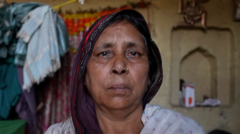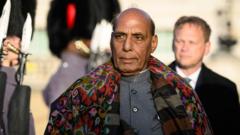After losing her husband in a tragic attack in Kashmir, Himanshi Narwal became a focal point of compassion and outrage. However, her call for peace has incited a wave of online abuse, highlighting the disturbing trend of victim-blaming and misogyny in the sphere of social media.
From Mourning to Misogyny: The Online Abuse of Kashmir Attack Survivor

From Mourning to Misogyny: The Online Abuse of Kashmir Attack Survivor
Himanshi Narwal, widow of a Kashmir attack victim, faces online trolling after her plea for peace amidst rising tensions.
In the aftermath of the tragic militant attack on civilians in Indian-administered Kashmir, one woman's heartfelt farewell to her husband captured the nation’s attention, only for her to become the target of an online hate campaign soon after. Himanshi Narwal was depicted in a heartbreaking photo, sitting beside the body of her husband, Vinay Narwal, a naval officer, after he was killed during their honeymoon on April 22. The attack left 26 people dead, and her sorrow struck a chord among the public, making her a symbol of the tragic loss.
However, within days, Narwal’s image took a darker turn as she faced backlash for speaking out against anger directed at Kashmiris and Muslims. During a blood donation camp marking what would have been her husband's 27th birthday, she appealed for peace, stating, "We want justice. The people who have wronged him should be punished," but urged not to generalize blame towards an entire community.
Following her appeal, the widow faced a torrent of vitriol online. Many who had initially expressed their condolences turned against her, accusing her of dishonoring her husband's memory. Disparaging comments surfaced, questioning her relationships with Kashmiri men from her university days and suggesting she had no right to voice her opinion since they were married for only a short time.
The National Commission for Women condemned the trolling as "extremely reprehensible and unfortunate." Chairperson Vijaya Rahatkar emphasized the need for decorum in expressing dissent, which resonated with many journalists in the field. Namita Bhandare, a gender issues reporter, criticized the disproportionate online abuse directed at Narwal, highlighting that she was targeted merely for promoting peace rather than revenge.
This sentiment echoed among other survivors like Arathi R Menon, who also faced criticism for her calm recounting of her father’s murder. Bhandare noted that such behavior reflects deep-rooted patriarchal tendencies, allowing attackers to feel emboldened in their anonymity.
Despite the hate, Narwal received messages of support from various quarters, including writer Gurmehar Kaur, who recognized the unimaginable strength Narwal displayed in the face of such a profound loss. Although the National Commission for Women has called attention to the inappropriate online behavior, no formal action has been taken against the accounts responsible for the abuse.
As the political landscape watches closely, opposition parties have urged government officials to support Narwal publicly. Yet to date, her narrative remains entwined in darkness, highlighting how social media can twist the trajectory of tragedy into a wave of societal hostility. Experts predict that this hate campaign will eventually dissipate, leaving the cycle of online abuse unbroken until the next target emerges.






















